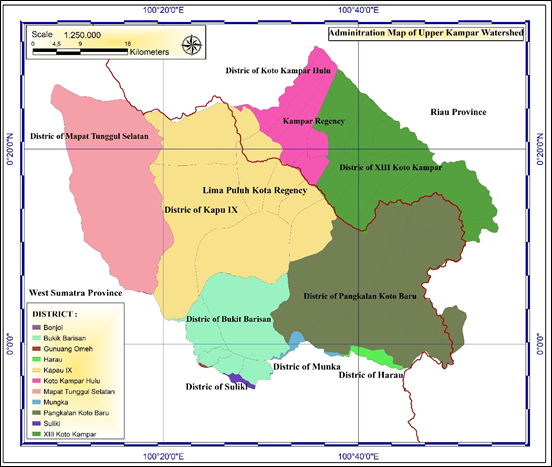Model for Optimizing Land Use to Support Sustainable Environmental Economic Strengthening in the Upper Kampar River Basin
DOI:
https://doi.org/10.25299/jgeet.2023.8.2.12906Keywords:
Scenario, land use, runoff reduction, cover crops, land optimizationAbstract
Simple and complex agroforestry systems can be implemented simultaneously in the cultivation area within the Upper Kampar River Basin. Based on the ArcSWAT simulation results, the surface runoff (Qsurf) was estimated to be 37.20 mm, which is significantly lower than the existing land use runoff in 2014, which was 102.12 mm. This forms the basis for implementing simple agroforestry and complex agroforestry systems in the Upper Kampar River Basin. The plant species that can support these agroforestry systems are selected based on the principles of land conservation and the suitability of local plants in the Upper Kampar Watershed environment. Four types of filler plants are considered: coffee and cocoa for the simple agroforestry system, and gambier and ambon bananas/kepok bananas for the complex agroforestry system. These plant species are the most dominant filler plants in the Upper Kampar Watershed. To optimize the land with these filler plant species, analysis is conducted using Quantitative Methods (QM) for Windows 4 software based on objective functions and constraint functions. The analysis determines that coffee is suitable for the simple agroforestry system, while gambier is suitable for the complex agroforestry system. Before land optimization with the planting of coffee, cocoa, gambier, and ambon bananas/kepok bananas, the net profit is estimated to be IDR. 359,113,963,811.06. After optimizing the land and developing it with the suitable filler plant species, only coffee and gambier are planted, while cocoa and ambon bananas/kepok bananas are planted according to the available area. As a result, the net profit increases to IDR. 951,426,300,000, with an economic value increase of IDR. 592,312,336,188.94 per year.
Downloads
References
A.F, E., Rosmeilisa, P., 2001. Analisis Usahatani Gambir di Sumatera Barat (Studi Kasus Kecamatan Harau, Kabupaten 50 Kota). J. Littri 7, 67–71.
Bps Kabupaten Lima Puluh Kota, 2017. Lima Puluh Kota Regency in Figures. Statistics of Lima Puluh Kota Regency : BPS, Sarilamak.
Fairuzi, S., 2008. Prospek Pengembangan Pisang di Sumatera Barat. J. Agribisnis Kerakyatan 1, 59–68.
Harsanto, B., 2011. Qm For Windows Tutorial Script. Magister Management Universitas Pajajaran, Bandung.
Hendri, M., Syahni, R., Nofialdi, Ifdal, 2021. Factors Affecting the Marketing Efficiency of Gambier Commodity in Lima Puluh Kota Regency, West Sumatra, Indonesia. Int. J. Agric. Sci. 4, 8–18.
Jong Jek Siang, 2011. No Titleriset Operasi : Dalam Pendekatan Algoritmis / Jong Jek Siang. Andi Ofset, Yogyakarta.
Lensari, D., Rosianty, Y., Syachroni, S.H., Paridawati, I., 2022. Optimalisasi Penggunaan Lahan Pekarangan dengan Sistem Agroforestri di Kota Prabumulih 3, 25–30.
Listyati, D., Sudjarmoko, B., Hasibuan, A.M., Randriani, E., 2017. Analisis Usaha Tani dan Rantai Tata Niaga Kopi Robusta di Bengkulu. J. Tanam. Ind. dan Penyegar 4, 145.
Nasution, A.H., Asmarantaka, R.W., Baga, L.M., 2015. Efisiensi Pemasaran Gambir di Kabupaten Lima Puluh Kota, Sumatera Barat. Bul. Ilm. Litbang Perdagang. 9, 221–239.
Niswarni, 2016. Peningkatan Hasil Belajar Program Linier Melalui Pendekatan Matematika Realistik di Kelas X Jasa Boga 1 Sekolah Menengah Kejuruan Negeri 6 Palembang. J. Pendidik. Mat. 6, 19–29.
Nurdin, Bahri, S., Zulkarnain, Sukendi, 2019. Hydrological Characteristics Analysis Due To Changes in Land Use With The Swat Model In The Koto Panjang Hydropower Catchment Area. Int. J. Civ. Eng. Technol. 10, 330–340.
P, F.K., Meydianawathi, L.G., 2014. Analisis Tingkat Daya Saing Ekspor Biji Kakao Indonesia Tahun 2007-2012. E-Jurnal Ep Unud 3, 502–512.
Rendra, P.P.R., Sulaksana, N., Alam, B.Y.C.S.S.S., 2016. Optimalisasi Pemanfaatan Sistem Agroforestri Sebagai Bentuk Adaptasi dan Mitigasi Tanah Longsor 14, 117–126.
Rianse, U., 2010. Agroforestri Solusi Sosial dan Ekonomi Pengolahan Sumber Daya Hutan, Pertama. Ed. Alfabeta, Bandung.
Rizal, M., Widowati, R., Rahayu, S.P., 2015. Perbaikan Teknologi Budidaya Pisang Kepok dan Analisis Usahataninya di Kabupaten Kutai Timur , Kalimantan Timur Technological Improvement of Banana Kepok Cultivation and its Analysis in East Kutai District , 1, 1678–1682.
Rotinsulu, F.N.C., Dundu, A.K.T., Tjakra, J., 2020. Pengembangan Perumahan Puri Kelapa Gading. J. Sipil Statik 8, 91–98.
Rumetna, M.S., Lina, T.N., Sari, T.P., Mugu, P., Assem, A., Sianturi, R., 2021. Computer Based Information System Journal Optimasi Jumlah Produksi Roti Menggunakan Program Linear dan Software Pom-Qm 09, 42–49.
Rusdiana, S., Martono, B., 2014. Analisis Finansial Diversifikasi Usaha Perkebunan. Sirinov 2, 157–170.
Suasti, Y., Hermon, D., Ahyuni, 2012. Dampak Pertambahan Penduduk Terhadap Konversi Lahan di Kota Padang. Pusat Penelitian Kependudukan dan Lingkungan Hidup (Pklh) Universitas Negeri Padang, Padang.
Ukrita, I., 201ad. Keunggulan Komparatif Kopi Sumatera Barat di Pasar Domestik. J. Penelit. Lumbung 12.

Downloads
Published
Issue
Section
License
Copyright @2019. This is an open-access article distributed under the terms of the Creative Commons Attribution-ShareAlike 4.0 International License which permits unrestricted use, distribution, and reproduction in any medium. Copyrights of all materials published in JGEET are freely available without charge to users or / institution. Users are allowed to read, download, copy, distribute, search, or link to full-text articles in this journal without asking by giving appropriate credit, provide a link to the license, and indicate if changes were made. All of the remix, transform, or build upon the material must distribute the contributions under the same license as the original.










